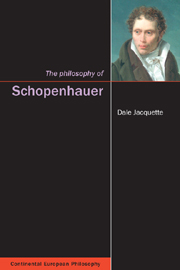Book contents
- Frontmatter
- Contents
- Dedication
- Preface
- Acknowledgements
- A note on texts and terminology
- Abbreviations
- Introduction: Schopenhauer's life and times
- 1 Schopenhauer's idealism
- 2 Empirical knowledge of the world as representation: from natural science to transcendental metaphysics
- 3 Willing and the world as Will
- 4 Suffering, salvation, death, and renunciation of the will to life
- 5 Art and aesthetics of the beautiful and sublime
- 6 Transcendental freedom of Will
- 7 Compassion as the philosophical foundation of morality
- 8 Schopenhauer's legacy in the philosophy of Nietzsche, Heidegger and the early Wittgenstein
- Notes
- Bibliography and recommended reading
- Index
Introduction: Schopenhauer's life and times
- Frontmatter
- Contents
- Dedication
- Preface
- Acknowledgements
- A note on texts and terminology
- Abbreviations
- Introduction: Schopenhauer's life and times
- 1 Schopenhauer's idealism
- 2 Empirical knowledge of the world as representation: from natural science to transcendental metaphysics
- 3 Willing and the world as Will
- 4 Suffering, salvation, death, and renunciation of the will to life
- 5 Art and aesthetics of the beautiful and sublime
- 6 Transcendental freedom of Will
- 7 Compassion as the philosophical foundation of morality
- 8 Schopenhauer's legacy in the philosophy of Nietzsche, Heidegger and the early Wittgenstein
- Notes
- Bibliography and recommended reading
- Index
Summary
For when I entered life, my genius offered me the choice of either recognizing truth but then of pleasing no one, or with others of teaching the false with encouragement and approbation; and for me the choice had not been difficult … Accordingly, I became the [man in the] iron mask … of the profession of philosophy, secluded from air and light so that no one would see me and my natural claims might not gain authority. But now the man who was killed by the silence of the professors of philosophy, has risen again from the dead, to their great consternation, for they do not know at all what expression they should now assume.
(PP 1: 135–6)An idealist synthesis
Arthur Schopenhauer crafted one of the most comprehensive philosophical systems the world has ever seen – not that the world paid much attention, at least at first. Schopenhauer weaves together ideas of Plato, Kant and Asian religions into an encyclopedic worldview that combines the empirical science of his day with mystic wisdom in a radically idealist metaphysics and epistemology.
The fundamental distinction in Schopenhauer's philosophy marks a dualistic conception of the world as representation, as it appears to thought, and as thing-in-itself, considered independently of all concepts and categories of mind. Schopenhauer identifies thing-in-itself as Will, which he further characterizes as blind urging or uncaused, unmotivated, objectless and subjectless striving or desire.
- Type
- Chapter
- Information
- The Philosophy of Schopenhauer , pp. 1 - 10Publisher: Acumen PublishingPrint publication year: 2005

